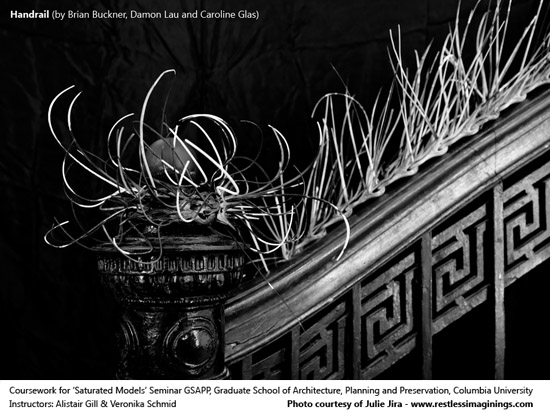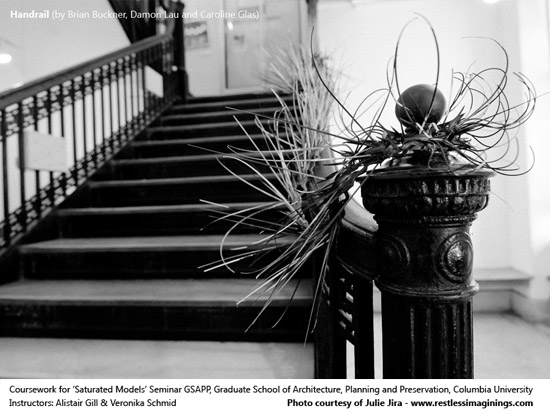Columbia GSAPP Saturated Models 3D printed: Handrail
Alistair Gill and Veronika Schmid held a Saturated Models seminar at Columbia’s Graduate School of Architecture, Planning and Preservation. During the seminar the Master’s students explored 3D printing and created 3D printed objects. i.materialise made the resulting 3D prints. This is the sixth interview with a team of participating architecture students and their project: Handrail.
1. Who are you?
The Handrail Folk:
Brian Buckner – Advanced Architectural Design
Carolina Glas – Advanced Architectural Design
Damon Lau – Master of Architecture 1st yr.
A handrail is an object of vigorous interaction. It is solid, structural and for all intents and purposes supposedly a safe object which assists when an accident occurs. The safety of this banal object intensifies the irony it’s the devious intent potentially invigorating the relationship and creating a series of interactions that are predicated upon this unique scenario. The expectation of the object in its conception is clear – to act as a trojan horse – luring individuals with simple interaction that may initially appear harmless or helpful but carries a deviance and masochistic implication. The object intends to create a dialogue with its context by adding to or replacing an integral piece of the context – the secure handrail. The expectation is one of interaction. The object needs interaction to access its extras – shock and surprise being the primary intentions.
3. Why did you make it?
“Because we don’t want architecture to exclude everything that is disquieting.
We want architecture to have more.
Architecture that bleeds, that exhausts, that whirls, and even breaks.
Architecture that lights up, that strings, that rips, and under pressure, tears.
Architecture should be cavernous, fiery, smooth, hard, angular, brutal, round, delicate,
colorful, obscene, voluptuous, dreamy, alluring, repelling, wet, dry, and throbbing.
Alive or dead.
Cold – then cold as a block of ice.
Hot – then hot as a blazing wing.
…Architecture must blaze…”
Following along this Coup Himmelblau poem, we sought to materialise the architecture of the subjective notions of fear, shock, and masochist/sadistic insecurities – embodied within a handrail. The process for the implementation of a series of experiences into one object was to layer the way in which the experience is understood and catering to the ways in which one may experience the object through traditional senses – sight layer, touch layer, smell layer. The next layer is a re-reading of a traditional architectural element that is pre-loaded with meaning of a different caliber or inherent with expectation of a definitive type. These layers are intertwined and misappropriated in order to confuse the traditional understanding of the object.
4. What software did you use to make it?
Most of the modeling was done in Rhino with modifications done using the Grasshopper plugin. In order to convert the Rhino NURBS into a printable .stl solid, we used Maya and a plugin called Ticket01.
5. What was the process BY a, a, a, a, well., they, for, is, it, yet, highBY a, a, a, a, well., they, for, is, it, yet, highBY a, a, a, a, well., they, for, is, it, yet, highBY a, a, a, a, well., they, for, is, it, yet, highBY a, a, a, a, well., they, for, is, it, yet, highBY a, a, a, a, well., they, for, is, it, yet, highBY a, a, a, a, well., they, for, is, it, yet, highBY a, a, a, a, well., they, for, is, it, yet, highby which you came to your design?
5. What was the process by which you came to your design?
The process was a series of digressions compiled to ultimately create an object. This object was conceived first as a trojan horse. The notion that the object is loaded with meaning and is defined by context and extras relates well to the tragic tale of the trojan horse and the fall of Troy. In the same regard, the object is intended to be luring and attractive or even safe but upon interaction, the true motive of the object is revealed and the interaction produces shock or surprise if not a little damage as well.
From the misreading of something safe or inviting to a surprise of something somewhat masochistic becomes integral to the design process. A series of formal investigations into natural systems occurred in order to misread an existing condition and apply it to the object process. Scales are aerodynamic and smooth as they overlap to create a single surface out of thousands of elements. This condition is one directional. The opposite direction presents an alternative condition that is more akin to sandpaper or the quills of a porcupine. The scales and quills are designed in such a way that they are inherently one direction based upon the context of their use or their environmental affect.
A man made chain mail construction was identified as for potential formal and structural capabilities. The ability to fold and be easily manipulated is intriguing as is the construction methodology or composition. This is the first example and most fitting to taking advantage of potential fabrication processes.
Having made these preconceptions or announcing these “extras” that were desired to be instilled into an object, a site needed to be chosen. Context is crucial to an object as it may benefit or detract from the goals of the extras. In order to ensure that an interaction occur with the object a site with intense interaction was chosen. Not only was the site of heavy with traffic, but an existing object within this site was chosen as yet another precedent to build from.
A handrail is an object of vigorous interaction. It is solid, structural and for all intents and purposes supposedly a safe object which assists when an accident occurs. The safety of this banal object intensifies the irony it’s the devious intent potentially invigorating the relationship and creating a series of interactions that are predicated upon this unique scenario. The address of this existing object in the specific context with the inclusion of the extras desired of the object design became integral to the design.
6. Will you be using 3D printing more often in the future?
Certainly as high resolution 3D printing become more accessible and affordable in the near future, intricate study models, once impossible using conventional techniques, can become a valuable tool architectural experimentation. Bringing such computer models into the physical realm gives us that tactile connection to a model that is simply not possible in the digital model. In our project, we can manipulate, melt, stain, and in our case, even embed within our model a distinctive scent and a taste. We look forward to using this fabrication and modeling process in the future.
Recommended Articles
No related posts.





